Kendal Parish Church
OS Grid ref:- SD 517922
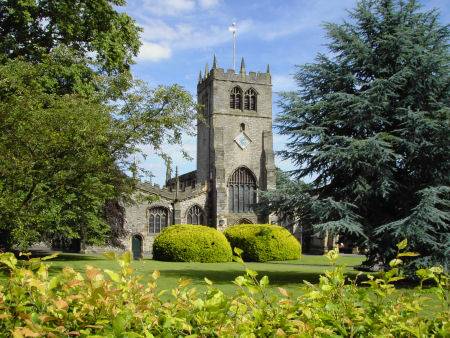 Kendal's Parish Church, Holy Trinity, with its five aisles and eighty feet tower, is the largest in England and is but 3 feet narrower than York Minster, measuring 140 feet long, and 103 feet wide. The building is sometimes referred to as the Church of Angels, due to the many carved wooden angels which adorn the church ceilings.
Kendal's Parish Church, Holy Trinity, with its five aisles and eighty feet tower, is the largest in England and is but 3 feet narrower than York Minster, measuring 140 feet long, and 103 feet wide. The building is sometimes referred to as the Church of Angels, due to the many carved wooden angels which adorn the church ceilings.
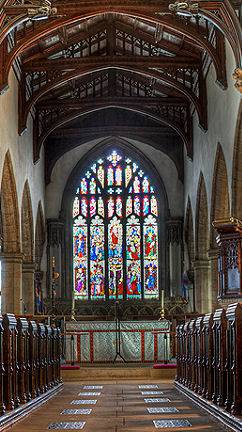 The present church dates largely from the eighteenth century. Although much of its fabric was built 1400-1600, when the Kendal cloth trade was at its peak.
The present church dates largely from the eighteenth century. Although much of its fabric was built 1400-1600, when the Kendal cloth trade was at its peak.
An earlier church is recorded in the Domesday Book of 1086. A church occupied the site during the Anglo-Saxon era, which was built using material taken from the ruined Roman fort at Watercrook which lies to the south of Kendal.
Westmorland was only subdued by the Normans in 1092, Ivo Taillebois became the first Norman Baron of Kendal, he granted the church and its valuable lands to St Mary's Abbey in York. In 1189, Duncan, Earl of Fife who led a Scottish marauding army into the town, many of the inhabitants of Kendal were massacred in church, where they had fled for protection.
The present building was constructed in 1201, the arch over the piscina was found inscribed with this date during a Victorian restoration. The building originally consisted of a nave, chancel, two aisles and the tower; the six nave pillars. lower part of the tower, pillars and the West Wall surviving to the present day. It is believed that some of the sandstone from the Saxon Church is incorporated in the current building.
Other parts of the building date to the fifteenth and sixteenth centuries. Holy Trinity has undergone much alteration over the proceeding centuries, extensive re-building and re-modelling took place in the 1800’s. The earliest piece of stone work housed in the church is a ninth century piece of an Anglian cross shaft.
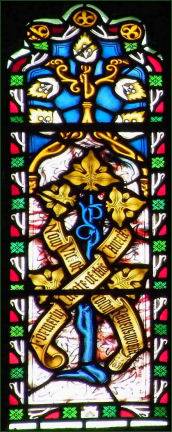 Very little of the ancient of the original ancient glass has survived to the present day, but there are many fine Victorian stained glass windows in the church. The black marble font dates to the fifteenth century, and the communion table to the seventeenth. The Reredos is of Caen stone with pillars of polished brown Kendal Fell marble dating from 1867.
Very little of the ancient of the original ancient glass has survived to the present day, but there are many fine Victorian stained glass windows in the church. The black marble font dates to the fifteenth century, and the communion table to the seventeenth. The Reredos is of Caen stone with pillars of polished brown Kendal Fell marble dating from 1867.
The south aisle was constructed in the fourteenth century to accommodate the Flemish Weavers when they came to start the town's woollen industry. The sculpture the Family of Man is the work of Josephine de Vasconcellos, a sculptor of Brazilian origin who lived in Cumbria much of her working life.
The Saint Thomas A' Beckett Chapel dates from the thirteenth century. The Pew ends in the chapel are fifteenth century. The Coat of Arms displayed is that of the Howard Family.
The Bellingham Chapel lies in the north east corner of the building. The chapel was built by Sir Roger Bellingham in the sixteenth century, it houses the tomb of Sir Roger and his wife Lady Margaret. The Bellinghams were from Burneside and Levens, and owned a house in Kendal. The chapel contains seventeenth century brasses that replace the originals that were stolen. The Corona was made in 1968 by the Keswick School of Industrial Arts in memory of Bernard Gilpin, "Apostle of the North" who attended Kendal Grammar School. Gilpin who was born at nearby Kentmere, was a famous Protestant preacher during the reign of King Henry VIII and at the time of the religious upheaval witnessed during the reign of his fanatically Catholic daughter, Mary I, known as 'Bloody Mary', for the number of Protestants who suffered burning at the stake during her reign. He was appointed a Fellow at the Queen's College, Oxford, Rector of Thornton-le-Moors, Vicar of Norton, Rector of Houghton-le-Spring and Archdeacon of Durham but declined the bishopric of Carlisle.
High on the North wall near the Bellingham chapel, hang a sword and helmet. These are said to have belonged to 'Robin the Devil', Sir Robert Phillipson of Belle Isle, Windermere. During the Civil War, Sir Robert, a local Royalist officer, was besieged by the Roundheads lead by Colonel Briggs, who fired cannon at Belle island from Cockshott Point, but his brother conducted a timely rescue. Burning with resentment at Briggs, Phillipson wildly rode his horse, sword in hand, into Kendal Parish Church and attempted to abduct Briggs during the course of the service. He was chased out by the outraged and indignant congregation. Leaving in haste, Sir Robert left his sword and helmet behind.
The Strickland Chapel, which is dedicated to St Catherine, dates to the thirteenth century, it contains the imposing tomb of Sir Walter Strickland who died in 1656. The Strickland family have lived at nearby Sizergh Castle for more than 750 years and it remains their home to the present day. At the west end of the inner north aisle is a memorial to George Sedgwick, the secretary of Lady Anne Clifford, High Sheriff of Westmorland.
The Parr Chapel
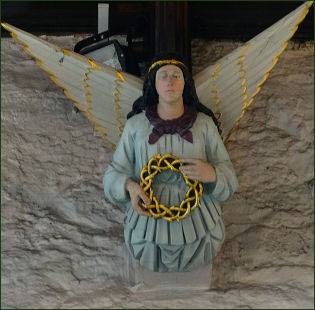 The Parr Chapel, situated at the south east of the church, dates to the fourteenth century and was built by the Parr family, a chantry priest was employed to offer daily prayers and masses for the souls of the family.
The Parr Chapel, situated at the south east of the church, dates to the fourteenth century and was built by the Parr family, a chantry priest was employed to offer daily prayers and masses for the souls of the family.
The Parr family lived at Kendal Castle and were descendants of King Edward III. The family originated from Parr in Lancashire and inherited Kendal Castle through marriage. Henry VIII's sixth and last wife Catherine Parr (1512 -1548) , who was fortunate enough to survive him, was the most famous member of the Parr family of Kendal and was born at Kendal Castle.
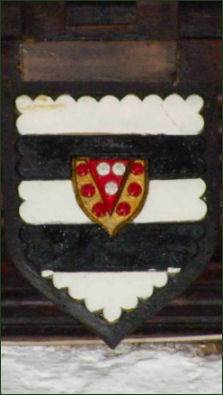 The Parr coat of arms is visible on the ceiling. The maidenheads also featured on the walls had long been associated with the Parr family coat of arms. The device of a maidens head was taken from the Ros of Kendal family who were ancestors of the Parr's. This emblem was incorporated into the badge that Catherine Parr used during her time as queen consort.
The Parr coat of arms is visible on the ceiling. The maidenheads also featured on the walls had long been associated with the Parr family coat of arms. The device of a maidens head was taken from the Ros of Kendal family who were ancestors of the Parr's. This emblem was incorporated into the badge that Catherine Parr used during her time as queen consort.
The Oak Screens were made in 1935 in a Kendal workshop. The shaft of an Anglian Cross, housed in the chapel is dated to approximately 850 A.D. and is the oldest object housed in the church.
The large and austere unpolished marble tomb in the chapel is reputed to be that of Catherine Parr's grandfather, William Parr, 1st Baron Parr of Kendal (1434–1483), The four angels carry the symbols of the Crucifixion, the cross, the crown of thorns, a ladder and hammer and nails.
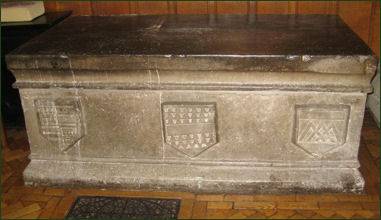 Sir William was the
eldest son of Sir Thomas Parr and Alice Tunstall, daughter of Sir Thomas Tunstall of Thurland, Lancashire. Sir Thomas was a close friend of King Edward IV. During the dynastic struggle known as the Wars of the Roses he fought on the side of the Nevilles at Banbury in 1469. He was sent by George Plantagenet, Duke of Clarence and Richard Neville, known to history as 'Warwick the Kingmaker' to Edward IV in March 1470, just before the Battle of Lose-coat Field. When Edward IV returned from exile in 1471 Parr brought 600 men-at-arms to him at Doncaster. He fought at the decisive Battle of Barnet, where his younger brother, Sir Thomas Parr was killed.
Sir William was the
eldest son of Sir Thomas Parr and Alice Tunstall, daughter of Sir Thomas Tunstall of Thurland, Lancashire. Sir Thomas was a close friend of King Edward IV. During the dynastic struggle known as the Wars of the Roses he fought on the side of the Nevilles at Banbury in 1469. He was sent by George Plantagenet, Duke of Clarence and Richard Neville, known to history as 'Warwick the Kingmaker' to Edward IV in March 1470, just before the Battle of Lose-coat Field. When Edward IV returned from exile in 1471 Parr brought 600 men-at-arms to him at Doncaster. He fought at the decisive Battle of Barnet, where his younger brother, Sir Thomas Parr was killed.
Parr sat as knight of the shire for Westmoreland in 1467 and 1473, was High Sheriff of Cumberland for 1473. Edward IV sent him on a mission to Scotland in 1479. He attended the funeral of Edward IV and when Richard III usurped the throne from his young nephew Edward V, Baron Parr chose not attend the new king's coronation in 1483. During Richard III's reign, William returned to the north and died shortly after.
Queen Catherine Parr was the daughter of William's eldest son, SirThomas Parr and his wife Maud Green.
There is a wide selection of cards and books available at the bookstall.
